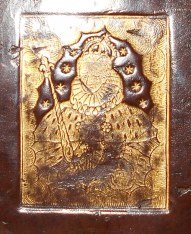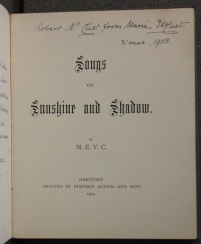
Amongst a collection of medical oddities housed at the Surgeons’ Hall Museum in Edinburgh lies a tattered pocketbook [left], no longer than the length of a man’s hand. It is dark brown—nearly black—with a pebbled texture and gold lettering that has begun to fade with age. To the untrained eye, it is altogether unremarkable in its appearance. However, upon closer inspection, the words ‘EXECUTED 28 JAN 1829’ and ‘BURKE’S SKIN POCKET BOOK’ come into focus, revealing the item’s true origins.
This is a book bound in the flesh of William Burke, the notorious murderer. Between 1827 and 1828, Burke and his accomplice, William Hare, drugged and killed 16 people for the sole purpose of selling their bodies to the anatomist, Dr Robert Knox. During their murder trial, Hare turned King’s Evidence in exchange for immunity. Burke was eventually found guilty of the murders and hanged before [ironically] being dissected in…
 I’ve moved my blog over to http://www.daniellewesterhof.co.uk/behind-the-spines. This unfortunately means that you will no longer automatically receive notification of new posts and other bits of information I like to share. Make sure you visit the new site, sign up (either to an RSS feed or email), and continue to learn more about the fascinating world behind the spines!
I’ve moved my blog over to http://www.daniellewesterhof.co.uk/behind-the-spines. This unfortunately means that you will no longer automatically receive notification of new posts and other bits of information I like to share. Make sure you visit the new site, sign up (either to an RSS feed or email), and continue to learn more about the fascinating world behind the spines!

![[Picture: Stack of old books, light background] [Picture: Stack of old books, light background]](https://i0.wp.com/www.fromoldbooks.org/pictures-of-old-books/pages/img_7378-stack-of-books/img_7378-stack-of-books-q67-303x500.jpg) My blog that is. Up to now, I’ve been using two different platforms for my website and my blog, which was not the most practical. I’m finally getting around to doing some more imaginative things with my website; being ever so slightly technophobic and techno-illiterate, I’ve been putting this off for ages! Using wordpress.org, I hope to have everything in the one place. It could all go horribly wrong and I loose everything, including your good selves following my tales of antiquarian books. But if not, it will be great!
My blog that is. Up to now, I’ve been using two different platforms for my website and my blog, which was not the most practical. I’m finally getting around to doing some more imaginative things with my website; being ever so slightly technophobic and techno-illiterate, I’ve been putting this off for ages! Using wordpress.org, I hope to have everything in the one place. It could all go horribly wrong and I loose everything, including your good selves following my tales of antiquarian books. But if not, it will be great!




